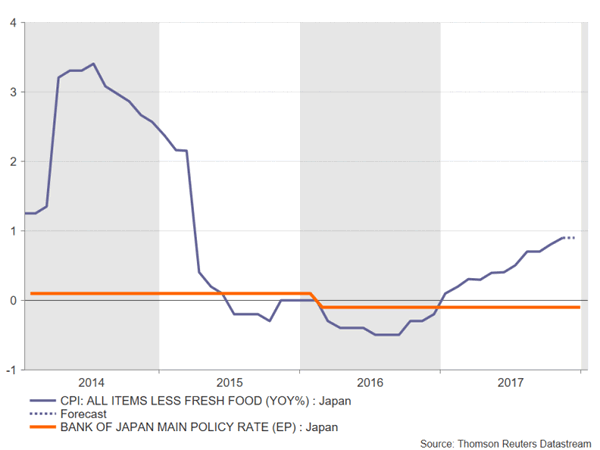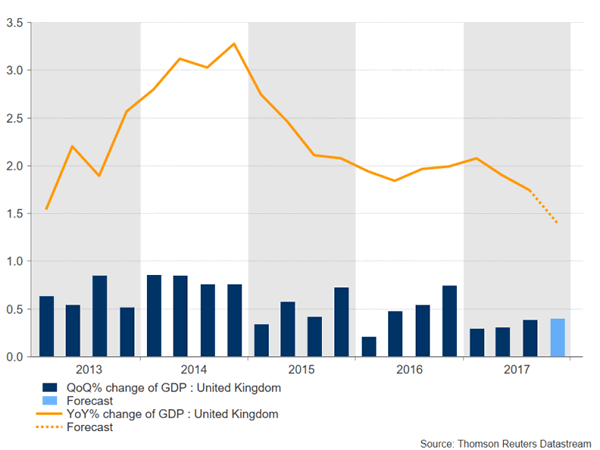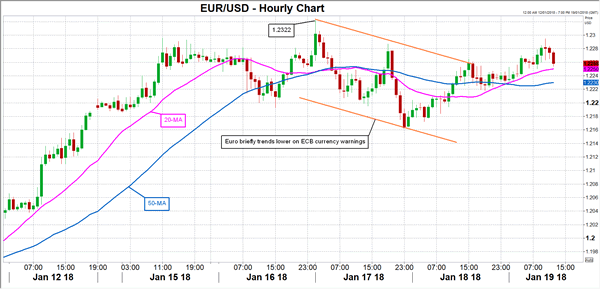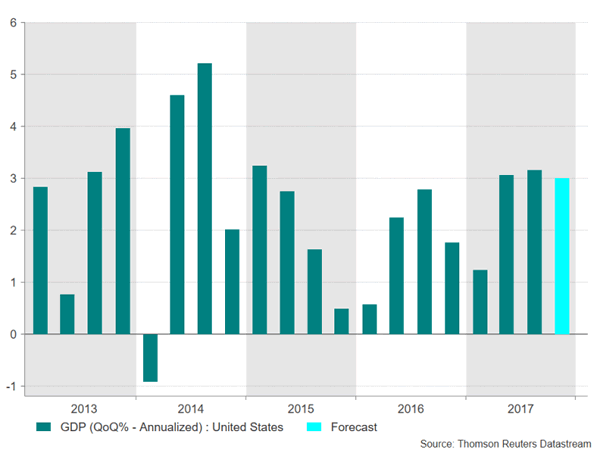The Bank of Japan and the European Central Bank will follow in the footsteps of the Bank of Canada to hold their first policy of 2018 in the next seven days. With speculative trade on the timing of the eventual stimulus withdrawal by both central banks driving the euro and the yen higher over the past couple of weeks, markets will be ultra-sensitive to the language spoken by policymakers. Economic data will also be at the forefront next week as preliminary estimates of fourth quarter growth are released in the UK and the US, as well as inflation numbers in Canada, Japan and New Zealand.
Another headliner next week will be the World Economic Forum in Davos. This year’s theme for the event, which is taking place between January 23-26, is "Creating a Shared Future in a Fractured World". However, the big talking point will likely be President Trump’s keynote speech on Friday. President Trump, who surprised many when he announced his attendance, could use the event to promote his protectionist ideology, potentially putting him on a collision course with other world leaders such as Germany’s Angela Merkel, the UK’s Theresa May and France’s Emmanuel Macron, who are also expected to attend.
Bank of Japan unlikely to shift tone
Japan’s central bank meets on Monday and Tuesday to decide whether an adjustment to its massive monetary stimulus program is required as the economy goes from strength to strength. Such a move is not expected to come anytime soon but there have been some indications recently that the BoJ is setting the ground to begin discussions on winding back its Quantitative and Qualitative Monetary Easing (QQE) with Yield Curve Control. A small reduction in the purchase of long-dated Japanese Government Bonds (JGB) by the BoJ on January 9 at a regular market operation spooked investors, raising fears that the Bank is about to join its European counterpart in announcing a cut in its asset purchase target. Markets were also alarmed when Bloomberg reported this week that some BoJ policymakers see the need to begin discussions on policy normalization soon.
More such signals, either in Tuesday’s announcement or Friday’s December meeting minutes could send the yen above this week’s 4-month high of 110.18 per US dollar. However, the Bank will likely stress that inflationary pressures are still elusive in Japan despite impressive growth in recent quarters. Core CPI, which excludes fresh foods and is targeted by the BoJ, remains below 1%. It was 0.9% in November and is forecast to stay unchanged in December when the data is released on Friday. Also to watch from Japan are Wednesday’s trade figures, which will include export numbers.

Inflation in focus in Canada and New Zealand
There will be more inflation data next week as New Zealand and Canada publish their latest figures on Thursday and Friday respectively. Canada’s inflation rate rose to 2.1% in November – a 10-month high. It is expected to ease slightly to 2.0% in December. A day earlier, retail sales numbers for the same month will be released, giving the first indication as to how well Canadian consumer spending held up towards the end of the year. Weaker-than-expected figures would likely further weigh on the Canadian dollar, which found itself back above C$1.24 to the US dollar after the Bank of Canada signalled future rate increases will be more gradual than the recent ones. The BoC hiked rates for a third time since July on Wednesday but struck an unexpectedly cautious tone, adding downside pressure on the loonie.
In contrast, the New Zealand dollar remains firmly on an uptrend that’s been in progress since November 2017. It hit a 4-month high of $0.7331 this week as the kiwi retraces its post-election losses. However, fourth quarter inflation data due in New Zealand on Thursday could spoil the rally if it points to an ongoing subdued outlook for consumer prices. The annual CPI rate rose to 1.9% in the third quarter, just below the middle of the Reserve Bank of New Zealand’s 1-3% target band. It is expected to stay at that level in the fourth quarter.
UK growth stuck in slow lane
Upward revision to previous GDP figures showed the UK economy performed slightly better post the Brexit referendum than initially estimated. Further optimism was added when growth in the third quarter accelerated slightly to 0.4% quarter-on-quarter from 0.3% in the first six months of 2017. The preliminary estimate of GDP for the final three months of 2017 due on Friday is expected to show another quarter of 0.4% growth. A stronger reading of 0.5% is possible though if manufacturing output receives a bigger-than-expected boost from exports. Ahead of the GDP report, unemployment data will be eyed on Wednesday. Jobs growth in the UK has been slowing in recent months, though average weekly earnings picked up to 2.5% in the three months to October. The Bank of England has based its rate hike projections on further tightening of the labour market over the coming months.

Disappointing readings next week could dampen expectations of a follow-up to last November’s 0.25% rate hike by the BoE anytime soon. Sterling, which is up almost 3% against the dollar so far in 2018 and is now looking overstretched, could become susceptible to profit-taking in the event of a data miss, whereas better-than-expected numbers could drive further gains.
Draghi a risk for the euro bulls
The ECB will take centre stage next week as it holds its first policy meeting of the year on Thursday. But before that, traders will be kept busy with a batch of business survey releases, starting with the ZEW economic sentiment index on Tuesday. The German gauge is forecast to rise to 18.0 in January from 17.4 in the prior month. Also on Tuesday is the flash reading of the Eurozone consumer confidence index. It will be followed by the IHS Markit Eurozone PMIs on Wednesday. The flash readings for January are expected to show a slight easing of activity in the manufacturing and services sectors. On Thursday, Germany’s closely watched Ifo business climate index is expected to hold at 117.2, just below November’s all-time high.
Attention will later shift to the ECB, which is anticipated to stand pat in January, having decided to trim its monthly bond purchases from €60 billion to €30 billion back in October. ECB policymakers have this week been attempting to talk down the euro’s recent surge, which hit a 3-year high of $1.2322 on Wednesday. The ECB’s chief, Mario Draghi, will likely use his press conference to warn of the negative impact on inflation from a sharp appreciation of the exchange rate. But it will also be interesting to see if he will reveal whether the Governing Council discussed updating their forward guidance on interest rates and giving an end date to the asset purchase program.

The ECB’s rate decision will be preceded by the Norwegian central bank’s own monetary policy announcement. At its December meeting, the Norges Bank said it expects to start raising interest rates sooner than expected, possibly in the autumn of 2018. The outlook was based on inflation rising more quickly as a result of a weaker krone. However, the Norwegian krone has been heading higher since the December meeting and this could force the Norges Bank to strike a less hawkish tone at its January meeting.
US GDP to maintain 3% growth path
The US calendar will get busier next week, with the highlight coming from the advance GDP reading for the fourth quarter. The first major release will be Wednesday’s manufacturing and services PMIs from IHS Markit for January, as well as existing home sales for December. New home sales will follow on Thursday. Both indicators are forecast to dip slightly month-on-month in December. Also on Thursday are December figures on the US trade balance and inventories.
But the big focus will be Friday’s durable goods and GDP numbers. Durable goods orders are forecast to increase for the second straight month, by 0.8% m/m in December. GDP growth meanwhile is expected to maintain similar momentum in the final quarter of 2017 as in the September quarter. The US economy is forecast to have expanded at an annualized rate of 3.0%, marginally below the prior 3.2% rate. A surprise strong print could fuel expectations of a more hawkish Fed when it meets on January 30-31 and would provide the greenback with a much-needed lift, having recently fallen to 3-year lows against a basket of currencies.

